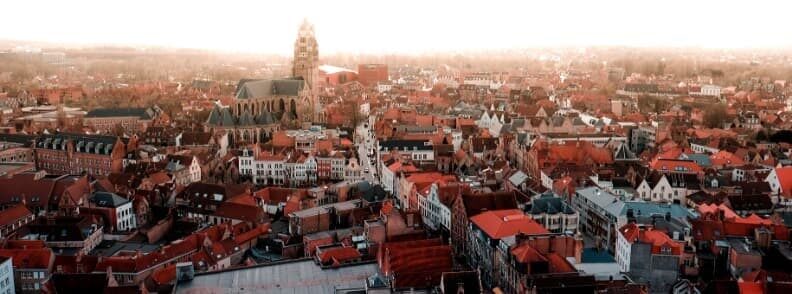Bruges, known as the Venice of the North, holds a special place in the heart of Flanders. Walking through this city is like stepping back in time. It’s a place where medieval architecture, serene canals, and centuries-old traditions come together in a way that feels both authentic and captivating. Bruges may be famous for its enchanting waterways and historic market squares, but when it comes to Bruges best things to do, there’s so much more to uncover if you take the time to explore beyond the postcard-perfect scenes.
This city’s unique layout, intertwined with its rich history, has earned Bruges a UNESCO World Heritage designation. And for good reason. As you wander its narrow streets, you’re surrounded by a living museum, where Gothic spires and intricate stone facades tell tales of a past full of wealth and power. Yet, Bruges isn’t frozen in time. It’s a vibrant, welcoming city where culture thrives, from the artwork of the Flemish Primitives to the lively energy of street markets and events.
If you’re wondering what to do in Brugge, this guide will take you through everything from historic landmarks to hidden gems that many visitors overlook. In this guide, I’m diving into the essential things to do in Bruges, covering everything for those wondering about Bruges what to do, not just the well-known spots but also a few cultural insights and local favorites that often go overlooked.
Expect a mix of iconic landmarks, like the towering Belfry of Bruges, and lesser-known experiences, such as a quiet stroll along the city ramparts. We’ll look at where to find the best views, where history whispers through the walls, and how to make the most of your time here, even if it’s just for a weekend.
And let’s not forget about the food. Belgian cuisine in Bruges goes beyond the famous chocolate and waffles (though those are must-tries). Imagine sampling mussels steamed in beer or warming up with a bowl of hearty waterzooi. I’ll share my favorite places to grab a drink, too, whether you’re craving a traditional lambic beer or something new from a local brewery. The city’s vibrant food scene offers a blend of French finesse and Flemish heartiness that’s worth diving into.
But more than just ticking off attractions, visiting Bruges is about experiencing its rhythms. You’ll learn about cultural customs that have endured for centuries, like the sacred Procession of the Holy Blood. Or you might get lost in quiet courtyards that hold secrets from the past. For those who want to soak in the atmosphere, I’ll guide you to the best spots for people-watching and slow walks, away from the main tourist paths.
This guide is designed to give you the complete Bruges experience, whether you’re here for a day, a weekend, or even longer. My goal is to help you make the most of your visit, enjoy every moment, and maybe even learn something new about this fascinating city. So, let’s dive in and uncover the best things to do in Bruges, from iconic sights to cultural treasures.
Disclosure: Some of the links below are affiliate links. This means that at no extra cost to you, The Travel Bunny will earn a small commission if you click through and make a purchase. Thank you!
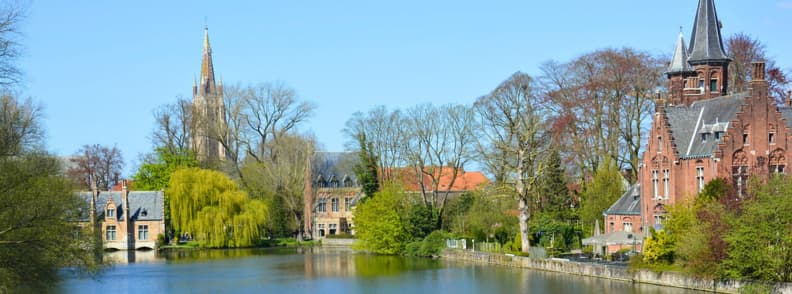
Essential Things to Know Before You Visit Bruges Belgium
Planning a visit to Bruges is exciting, especially when you’re ready to explore all the best things to do in Bruges. Known as the Venice of the North, this medieval city is packed with history, scenic canals, and stunning architecture that make it a traveler’s dream. Before you dive into the heart of this UNESCO World Heritage Site, it’s helpful to know some key details about language, currency, and how to make the most of your time here. From saving money with the Brugge City Card to understanding the best ways to get around, here’s everything you need to know to make your experience in Bruges both memorable and stress-free.
Language & Currency
In Bruges, Dutch is the official language, but you’ll find that English and French are widely spoken, making communication straightforward. The currency is the Euro (€), so it’s convenient to have some cash on hand for small purchases, though credit cards are commonly accepted.
ATMs are widely available throughout Bruges, and most accept international cards. It’s advisable to inform your bank of your travel plans to avoid any issues with card transactions. While Bruges is generally safe, it’s wise to stay vigilant, especially in crowded areas. Keep your belongings secure and be aware of your surroundings to prevent petty theft.
Brugge City Card
Consider getting the Brugge City Card. It offers access to 27 best museums in Bruges and includes a boat tour, providing a cost-effective way to explore the city’s attractions. The card also comes with various discounts, enhancing your experience without straining your budget.
Best Time to Visit
Bruges has its charm year-round, but timing your visit can enhance your experience. The city is most crowded from June through October, with the peak season in July and August. If you prefer a quieter atmosphere, consider visiting during the shoulder seasons — mid-March through May or November through early March. These periods offer milder weather and fewer tourists, allowing for a more relaxed exploration.
Where to Stay in Bruges
Bruges offers a range of accommodations to suit various preferences and budgets. For a luxurious experience, consider Relais & Châteaux Hotel Heritage, known for its central location and exemplary service. If you prefer a more intimate setting, charming bed and breakfasts like Huis Koning provide a cozy atmosphere with personalized touches. For budget-conscious travelers, hostels such as Snuffel Hostel offer affordable options without compromising on comfort.
Transportation
Navigating Bruges is straightforward. The city’s compact size makes walking an excellent option to soak in the medieval architecture. For a local experience, rent a bike. Bruges is bike-friendly, with many one-way streets allowing two-way cycling. Canal boat rides provide a unique perspective of the city and are a must-try. Public buses are available, but for most attractions, walking or cycling suffices.
By keeping these points in mind, you’ll be well-prepared to enjoy all the things to do in Bruges.
Top 10 Things to See in Brugge Belgium
Bruges has a way of making even a regular day feel extraordinary, and as someone from Flanders, I never tire of the city’s charm. The medieval architecture, winding canals, and hidden courtyards give you plenty of options for things to do in Bruges, whether you’re seeing it for the first time or discovering something new.
Exploring the top ten things to do in Bruges is like stepping into a time capsule, with each site offering a unique glimpse into the city’s rich history and vibrant culture. You can spend hours getting lost among historic buildings like the Basilica of the Holy Blood or marveling at art in the Groeninge Museum. The old beer culture is also strong here, with plenty of cozy spots to sample local brews, and when the weather is good, I always find myself enjoying the green spaces around Minnewater Park. Even after countless visits, Bruges always manages to surprise me with little moments that make it a place worth exploring, over and over.
Knowing what to visit in Bruges can feel overwhelming with so many options. That’s why I’ve curated this guide to help you make the most of your time in this captivating city.
10. Walplein Square & Brewery De Halve Maan
When you think of Bruges, one of the best things to do is visit Walplein Square. Trust me, it’s an experience you won’t forget. Tucked in the heart of the city, Walplein is a lively hub that feels like a celebration of Bruges’ rich beer culture. It’s a spot to wander around but also the home of Brewery De Halve Maan, a place where tradition meets innovation in the most fascinating way.
I remember my first visit to De Halve Maan vividly. It was like a deep dive into the soul of Bruges. This brewery has been family-run since 1856, and they’ve kept their brewing traditions alive while embracing some wild ideas — like their underground beer pipeline. Yes, you read that right. There’s a three-kilometer pipeline running beneath Bruges, pumping freshly brewed Brugse Zot beer out to their bottling plant on the city’s outskirts. As someone who loves quirky details, I found this engineering marvel as compelling as the beer itself.
The brewery tour takes you through their brewing process, from the malt and hops to the aging tanks. The guide shared stories that gave the place character, and I couldn’t help but be impressed by how De Halve Maan managed to solve their logistical problem of beer transport. Before the pipeline, trucks constantly hauled beer in and out, disrupting the charm of Bruges’ old streets. Now, beer flows silently underground. The innovation is as much a relief for the city as it is a tribute to the brewery’s dedication to quality.
After the tour, I made sure to try both Brugse Zot and Straffe Hendrik, two local favorites. There’s something special about tasting a beer just a few steps from where it’s brewed. The flavors felt richer, and fresher, like they belonged to the city itself. If you’re a beer lover — or even just beer curious — this is a must-do in Bruges!
But what really got me thinking was the story behind the Brugse Zot name. Legend has it that the people of Bruges earned this “foolish” nickname from Maximilian of Austria after he refused to fund a new asylum. He called Bruges itself one big madhouse (zothuis). The locals embraced the joke, and now it’s immortalized in their most famous beer. It’s little cultural nuggets like these that make exploring Bruges so rewarding.
If you visit, give yourself time to soak up the atmosphere of Walplein. Whether you’re sitting at an outdoor café or joining a brewery tour, it’s one of those places where the spirit of Bruges truly comes alive. Just don’t leave without raising a glass of Brugse Zot to this city that knows how to blend history and modernity in the most unexpected ways.
9. Fish Market (Vismarkt)
When exploring Bruges, the Vismarkt, or Fish Market, is a must-see. Established in the early 19th century, this market has been the city’s central hub for seafood trade. Originally, fishmongers sold their catch in various spots around Bruges, but in 1820, city architect Jean-Robert Calloigne designed the current colonnaded structure to centralize the trade.
Visit the Vismarkt from Wednesday to Saturday mornings to experience its lively atmosphere. Local vendors offer a variety of fresh North Sea fish and seafood, reflecting Bruges’ rich maritime heritage. Beyond seafood, you’ll find artisans selling crafts, making it a great spot to pick up unique souvenirs.
While there, take a moment to appreciate the central water pump and obelisk, which add to the market’s historic charm. The surrounding colonnades not only provide shelter but also showcase the architectural style of the period. Even if you’re not shopping, the Vismarkt offers a glimpse into the daily life of Bruges and its enduring traditions.
Including the Vismarkt in your itinerary is one of the top things to do in Bruges, offering both a cultural and culinary experience.
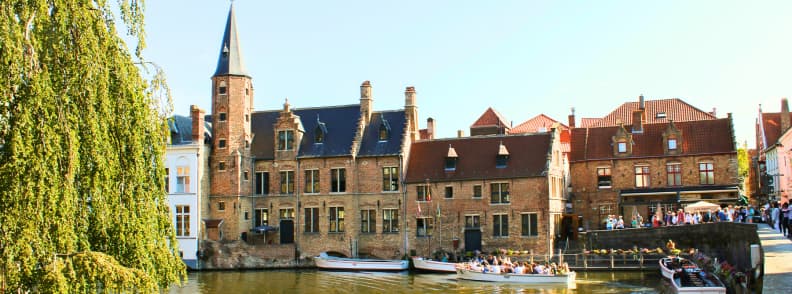
8. Tanners Square (Huidenvettersplein)
When exploring things to do in Bruges, a visit to Tanners Square offers a glimpse into the city’s medieval past. This small, L-shaped square, known as Huidenvettersplein, was once the hub for leather tanners. In the Middle Ages, tanners processed hides here, contributing significantly to Bruges’ economy. The square’s name reflects this history, with Huidenvetters translating to tanners in Dutch.
One notable building in Tanners Square is the former inn ‘e Groote Hollander. This establishment served as a gathering place for tanners after their workday. The façade features a cow sculpture above the door and scenes of leather processing, highlighting its connection to the tanning trade.
The tanners’ trade was essential to Bruges’ development. Leather goods were in high demand, and the tanners’ guild played a vital role in the city’s economy. Their work supported various industries, from shoemaking to bookbinding, and contributed to Bruges’ reputation as a center of commerce.
Today, Tanners Square is a charming spot to pause and reflect on Bruges’ rich history. The medieval architecture and historical significance make it a worthwhile stop on your exploration of the city.
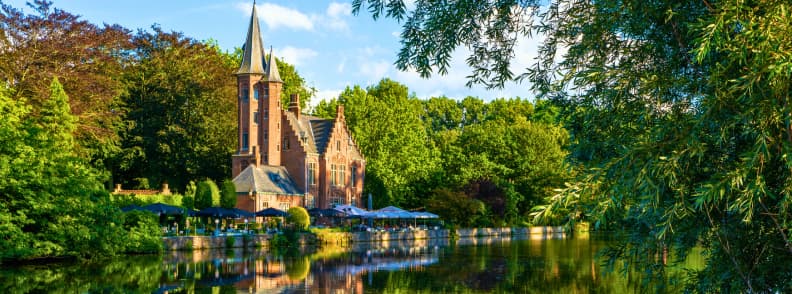
7. Minnewaterpark & Lake of Love
One of the top things to do in Bruges is visit Minnewaterpark and the Lake of Love. This serene spot offers a peaceful retreat from the city’s bustling streets. The park’s tranquil paths and the lake’s calm waters create an ideal setting for a leisurely walk or a quiet picnic.
The Lake of Love is a picturesque location with a poignant legend. Local lore tells of Minna, a young woman who fell in love with Stromberg, a warrior from a rival tribe. Their forbidden love led to tragedy, and Minna’s name became forever linked to the lake. It’s said that couples who cross the Minnewater Bridge together will experience eternal love.
For photography enthusiasts, Minnewaterpark offers several excellent vantage points. The Minnewater Bridge provides a panoramic view of the lake, especially enchanting during sunrise or sunset. The reflections of the surrounding trees and historic buildings on the water’s surface make for captivating shots. Additionally, the park’s pathways lined with mature trees offer charming backdrops for portraits or candid photos.
Including Minnewaterpark in your itinerary is a must when considering what to do in Bruges. Its combination of natural beauty, romantic history, and photographic opportunities makes it a standout destination in the city.
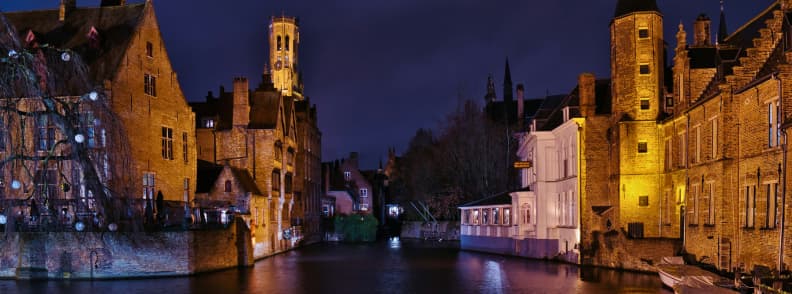
6. Rosary Quay (Rozenhoedkaai)
Rosary Quay, or Rozenhoedkaai, is one of those places in Bruges that will stick with you long after you leave. If you’re planning a list of things to do in Bruges, this iconic photo spot needs to be near the top. It’s one of the most photographed locations in the city, and for good reason. Standing here, you get a stunning view of where the Groenerei and Dijver canals meet, framed by medieval buildings and the Belfry Tower rising in the distance. The reflection of these historic facades in the calm water creates a scene so picturesque, that it almost feels unreal.
But Rosary Quay isn’t just a pretty backdrop. This quay carries the weight of centuries of history, and its transformation from the Salt Dike to the bustling spot we see today is a story worth knowing. Back in medieval times, this area was known as Zoutdijk or Salt Dike because ships docked here to unload precious salt. Salt wasn’t just a seasoning back then. It was essential for preserving food, so much so that it was often referred to as white gold. This quay was a hive of activity, crucial to Bruges’ role as a major trading hub in Northern Europe.
Fast forward to the 18th century, and the quay took on a different significance. It became known as Rozenhoedkaai or Rosary Quay because rosary vendors started selling prayer beads here. The name stuck, even as times changed. Today, while you won’t find rosary sellers lining the quay, the history is still palpable in every cobblestone and in the way the past and present seamlessly coexist.
If you’re wondering when to visit Rosary Quay to capture its magic on camera, timing is everything. Early mornings are ideal if you want a serene experience. The soft, golden light casts a warm glow on the buildings, and there’s often a gentle mist rising from the canals, giving your photos an ethereal quality. In the evening, the atmosphere shifts but remains just as enchanting. As the sun dips, the city lights come on, illuminating the medieval architecture and creating a beautiful contrast with the twilight sky. The reflections in the canal become even more striking, making it a perfect moment to snap that postcard-worthy shot.
Local tip. Even if photography isn’t your thing, take a moment to pause here, soak in the scenery, and feel the history that has flowed through this quay over the centuries. Whether you’re a visitor seeing Bruges for the first time or a local rediscovering its charm, Rosary Quay has a way of captivating everyone who passes by.
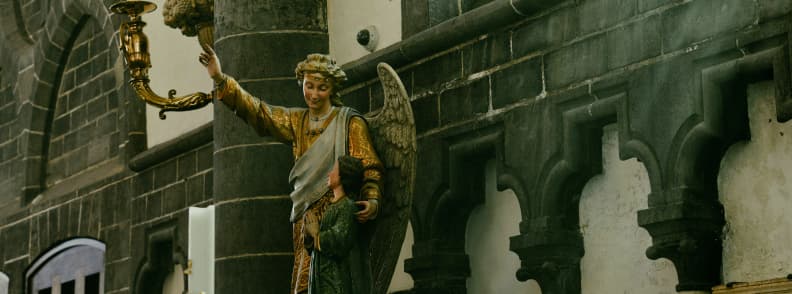
5. Gruuthuse Museum & Church of Our Lady
When planning your list of things to do Bruges, the Gruuthuse Museum and the Church of Our Lady should be at the top. These landmarks are perfect for history enthusiasts and art lovers who want to dig deep into the city’s past and admire architectural marvels.
Step into the former palace of the Lords of Gruuthuse and explore one of Bruges’ best-preserved relics of the Burgundian era. This museum is a living record of how the city thrived as a trading powerhouse. The collection includes everything from medieval tapestries and detailed wooden sculptures to delicate Chinese porcelain. One of my favorite parts? The ornate kitchen utensils, which hint at the lavish feasts held here in the 15th century. You can really sense the wealth and influence that defined Bruges’s heyday.
But the real showstopper is the oratory, a beautifully preserved 15th-century space that directly connects to the Church of Our Lady. Standing in this private chapel, where the Lords of Gruuthuse once attended mass without mingling with the common people, you get a unique perspective. From there, you can look out over the Gothic chancel of the church, taking in the grandeur that speaks to the era’s religious devotion and social hierarchy.
Just next door, the Church of Our Lady is an architectural wonder in its own right, with its 115.5-meter tower — the second tallest brick structure in the world. Inside, the highlight is Michelangelo’s Madonna and Child, a rare masterpiece that left Italy during the artist’s lifetime. It’s humbling to stand before such an exquisite sculpture, and even more so knowing it survived centuries of history to be admired here in Bruges. The church also holds the impressive tombs of Mary of Burgundy and her father, Charles the Bold. Their effigies rest in detailed splendor, surrounded by stained glass that filters the light in a way that brings their legacy to life.
Visiting these sites not only deepens your appreciation for Bruges’ art and history but also gives you a real sense of the city’s medieval prominence. It’s easy to see why these landmarks are among the top things to do in Bruges and why they continue to captivate everyone who visits. As you explore, keep in mind that these tourist attractions are also chapters in a story that Bruges has been telling for centuries.
4. St. John’s Hospital
When you’re looking for things to do in Bruges, one place that stands out for its sheer historical significance and unique experience is St. John’s Hospital. This is one of the oldest hospital complexes in Europe, dating back to the 12th century. Imagine walking through a space where medieval monks and nuns once worked tirelessly to care for the sick and the poor, long before modern medicine existed.
As you step inside, you’ll find yourself in a museum that brings Bruges’s past vividly to life. The highlight here is the collection of works by Hans Memling, a Flemish primitive whose masterpieces are displayed in what used to be the hospital wards. One of his most famous pieces, the St. Ursula Shrine, is a stunning, intricately detailed reliquary that tells the story of St. Ursula and her companions. You’ll see how the lines between art, religion, and healthcare were blurred in this place – a reminder of how art served both a spiritual and practical purpose in medieval times.
But what truly sets St. John’s Hospital apart is its more intimate features, like the 17th-century pharmacy. You’ll get a peek into a fully preserved apothecary, where nuns once concocted remedies using herbs grown right outside in the hospital’s medicinal garden. The shelves still hold glass jars and wooden drawers, each labeled with the name of a long-forgotten cure. Seeing this, you start to understand how medicine was a mix of science and faith, with herbal knowledge passed down over centuries.
If you’ve got an interest in historical medicine or simply love uncovering the stories old buildings tell, this place will fascinate you. And don’t miss the herb garden. It’s small but packed with traditional medicinal plants like lavender, sage, and feverfew. While it’s easy to overlook, the garden completes the story of how self-sufficient the hospital once was, growing its own treatments in a time when pharmacies as we know them didn’t exist.
In a city where nearly every street corner whispers stories of the past, St. John’s Hospital stands out as a place where you can feel the weight of history mixed with art and healing. Make sure to include it in your itinerary when you’re exploring things to do in Bruges, and let it transport you back to a time when care for the soul was as important as care for the body.
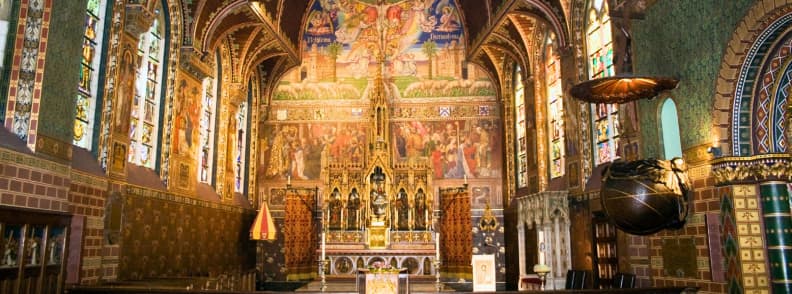
3. Basilica of the Holy Blood
The Basilica of the Holy Blood is one of the most fascinating things to do in Bruges, and it stands out for both its spiritual significance and its architectural splendor. Located in the bustling Burg Square, this iconic site is steeped in legend and history, making it a must-visit for any traveler eager to uncover Bruges’ deep-rooted past.
Inside the basilica, you’ll find one of the most sacred relics in Europe: a crystal vial said to contain a cloth stained with the blood of Jesus Christ. The story goes that the relic was brought to Bruges after the Second Crusade, around 1150, and it has been carefully preserved here ever since.
Each year, the relic plays a central role in the Procession of the Holy Blood, an event that transforms the city with medieval pageantry, drawing thousands of visitors to witness this extraordinary display of faith and tradition. If you’re planning a visit around Ascension Day, be sure to catch this impressive procession, which is one of the most memorable experiences in Bruges.
The basilica is a marvel of contrasting styles. The lower chapel, dedicated to Saint Basil, dates back to the 12th century and is a rare example of Romanesque architecture in this part of Belgium. It has a simple, somber elegance, with rounded arches and heavy stone pillars that transport you back to the medieval era. As you climb the narrow stairs to the upper chapel, the atmosphere shifts dramatically. Here, you’ll find a stunning neo-Gothic interior, added in the 19th century, featuring vivid stained-glass windows, elaborate carvings, and a kaleidoscope of colors that fill the space with a sense of awe. The juxtaposition between the two chapels is striking and offers a glimpse into Bruges’ evolution over the centuries.
When visiting the Basilica of the Holy Blood, timing is key. The relic is on display for veneration every afternoon from 14:00 to 16:00, and on Fridays, an additional viewing is available from 10:15 to 11:00. If you’re interested in attending Mass, keep in mind that the upper chapel is closed to visitors during services, which typically occur on Fridays, Sundays, and festival days between 10:45 and 12:15. Arriving outside of these times will allow you to explore both chapels at your leisure and fully appreciate the basilica’s architectural beauty.
Don’t miss the opportunity to experience this spiritual and historic treasure while exploring all the best things to do in Bruges. The Basilica of the Holy Blood is a place of worship that takes you on a journey through time, offering insights into Bruges’ role as a center of medieval faith and art.
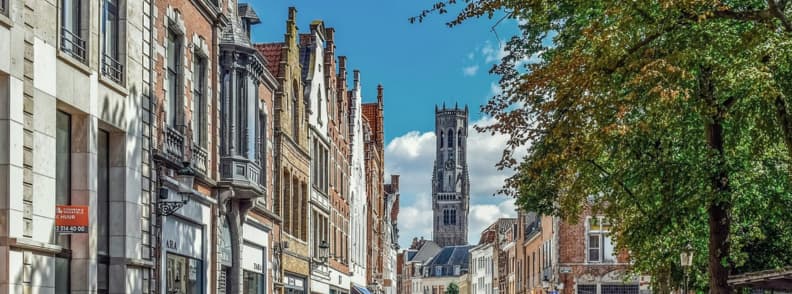
2. Market Square (Grote Markt) & Belfry Tower
When you’re exploring the heart of Bruges, the Market Square (Grote Markt) and the Belfry Tower are two landmarks that are windows into the city’s rich past and lively present. Let me tell you why this spot is unmissable when you’re ticking off the top things to do in Bruges.
The Belfry Tower is hard to miss, at 83 meters above the square. Climbing the 366 narrow, spiraling steps is no small feat, and if you’re like me, you’ll feel your thighs burning long before you reach the top. But it’s worth every bead of sweat. The higher you go, the more you get that sense of anticipation, knowing you’re about to see Bruges in a way few ever do.
When you finally make it to the viewing platform, it’s breathtaking — panoramic views stretching across medieval rooftops, church spires, and the famous canals that wind their way through the city. I’ve never quite gotten over the feeling of standing up there, the wind in my face, watching the entire city unfold below.
Back down on solid ground, the Grote Markt is buzzing with energy. It’s the beating heart of Bruges, and there’s always something happening. You’ll see horse-drawn carriages clattering across the cobblestones, street musicians filling the air with music, and outdoor cafes packed with people soaking in the scene. The Provincial Court stands proud on one side of the square, and you can’t miss the statues of Jan Breydel and Pieter de Coninck, two local heroes who fought for Bruges’ independence. It’s like being surrounded by history that’s still very much alive.
And, of course, I can’t talk about Market Square without mentioning the food. You’ve got to try the Belgian fries from one of the nearby stands. These aren’t your average fries. They’re golden, crispy perfection, usually served with a dollop of mayonnaise. You might be skeptical at first but trust me, once you try it, you’ll understand why the we Belgians swear by it. Grab a cone of fries, find a spot to sit, and just take it all in. Watching the square’s hustle and bustle while munching on those fries? That’s one of the simple pleasures of Bruges you shouldn’t miss.
When you’re planning things to do in Bruges, put the Belfry Tower and the Grote Markt at the top of your list. They offer you a full sensory experience, from the weight of history to the taste of the city. You’ll leave with memories that stick, long after you’ve left Bruges behind.
1. Burg Square
If you’re exploring the best things to do in Bruges, you should definitely start with Burg Square. This place has been central to Bruges’s history since the 9th century, and it shows. Growing up here, I never realized how much I’d come to appreciate the weight of history that surrounds it, but as you walk through, it’s hard to miss. That’s why to me it’s the best of Bruges!
City Hall stands as a testament to centuries of governance. This Gothic building, one of the oldest in the Low Countries, has witnessed more than 600 years of decisions that shaped Bruges. Its stone façade is detailed and commanding, and the Gothic Hall inside is still used today for city council meetings and weddings. It’s a place that embodies the city’s legacy, and every local knows its significance.
The architectural variety in Burg Square has always fascinated me. You’ll see the Romanesque Basilica of the Holy Blood on one side, holding a relic that’s revered and celebrated every Ascension Day. The Old Civil Registry, with its Renaissance style, adds elegance, while the Baroque Provostry of St. Donatian completes the eclectic mix. It’s a spot where architectural eras meet, and each one tells part of Bruges’ story.
And then there are the legends. We’ve grown up with the tale of the bear, our city’s oldest “resident”. It’s said that Baldwin I, the first Count of Flanders, encountered a bear right here in Burg Square and defeated it. That bear became a symbol of strength and has been part of Bruges’ identity ever since. Even today, you’ll see its image in our city’s coat of arms, a reminder of our medieval past.
Burg Square holds so much of what makes Bruges special. It’s where the city’s history, architecture, and myths come together, and even for locals, it’s a place that never loses its significance. If you’re looking for what to do in Bruges, this square should be at the top of your list. It offers a glimpse into the soul of our city.
Enjoy the Best Things to Do in Bruges Belgium
Bruges is brimming with unforgettable experiences, from exploring medieval streets to gliding along its peaceful canals. As you uncover the many things to do in Bruges, you’ll find that each moment brings a new way to appreciate the city’s unique charm. Whether it’s visiting iconic sites like the Belfry Tower and Market Square or strolling through Minnewaterpark, Bruges leaves a lasting impression.
While enjoying the top things to do in Bruges, take a moment to reflect on how your presence can help protect this historic destination. Respect the city’s heritage, keep the canals and cobbled lanes clean, and support local businesses that preserve Bruges’ character. Every step you take contributes to ensuring future visitors can soak in the same wonders.
Thank you for walking through this guide of things to do in Bruges. I hope you leave with incredible memories and a desire to return to this captivating city, ready to experience even more of what Bruges has to offer.
Still wondering what is there to do in Bruges? Take this guide as your starting point, and be sure to explore beyond the iconic sights to make the most of your visit.
The Very Best Things to Do in Bruges Are Recommended By…

I’m Olivia Peeters, a sustainable travel enthusiast from Flanders with a passion for Bruges and the surrounding countryside. Over the years, I’ve dedicated myself to discovering the best things to do Bruges Belgium, while keeping environmental responsibility at the forefront. From navigating Bruges’s picturesque canals by electric boat to cycling through the city’s cobbled streets and out to the serene villages nearby, I’ve experienced this enchanting area in every way possible.
My expertise lies in sustainable adventures—think hiking trails that unveil the quieter corners of Bruges or local tours that prioritize eco-friendly practices. I’m here to help you make the most of your visit with advice rooted in firsthand experiences and a deep understanding of how to explore Bruges responsibly. Let me show you how to enjoy the best sights while leaving a minimal footprint on this historic city.
You too can become a guest blogger on The Travel Bunny. Just submit a free guest post.
Other travel blog articles you should read on The Travel Bunny
Visit Bruges: A short travel guide
Best 3 things to do in Belgium
Why Visit Antwerp — The Best Travel Guide for an Amazing Experience

